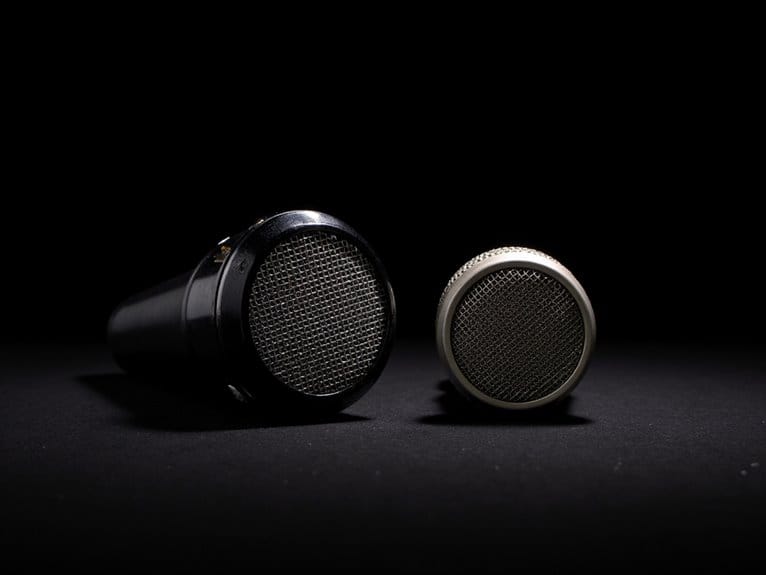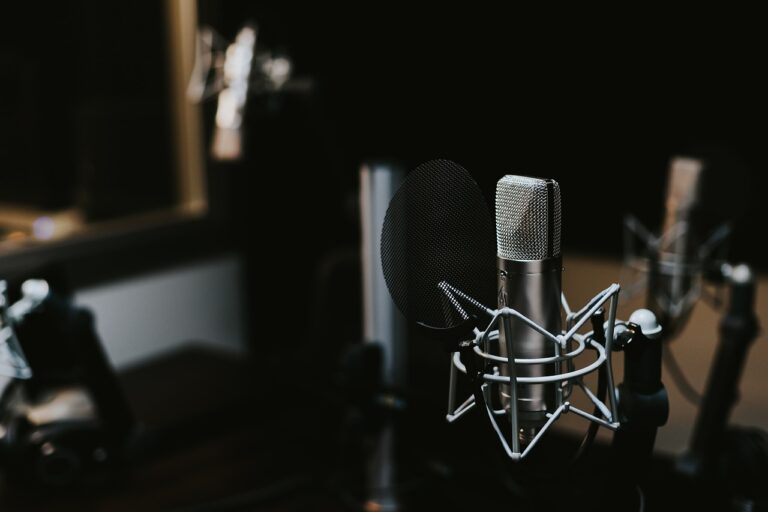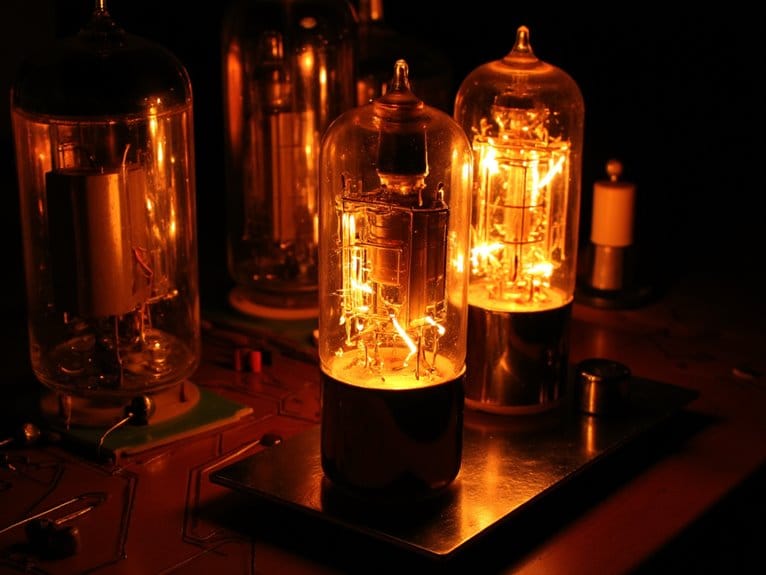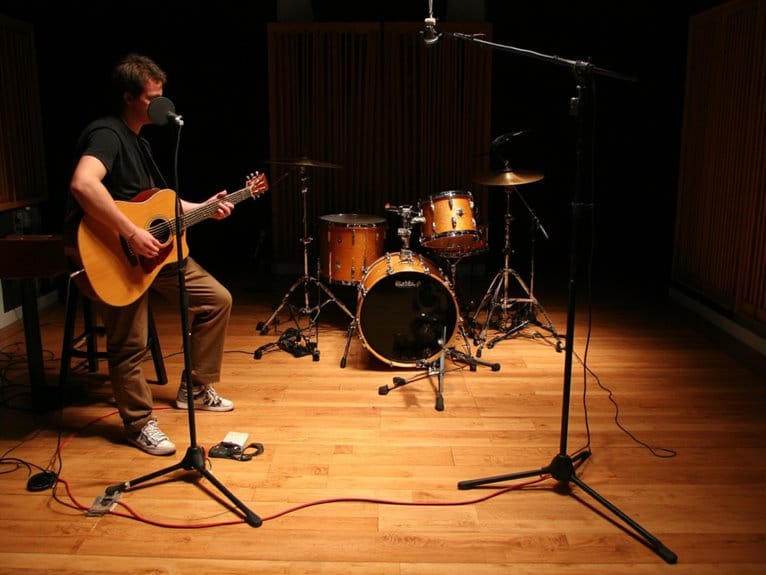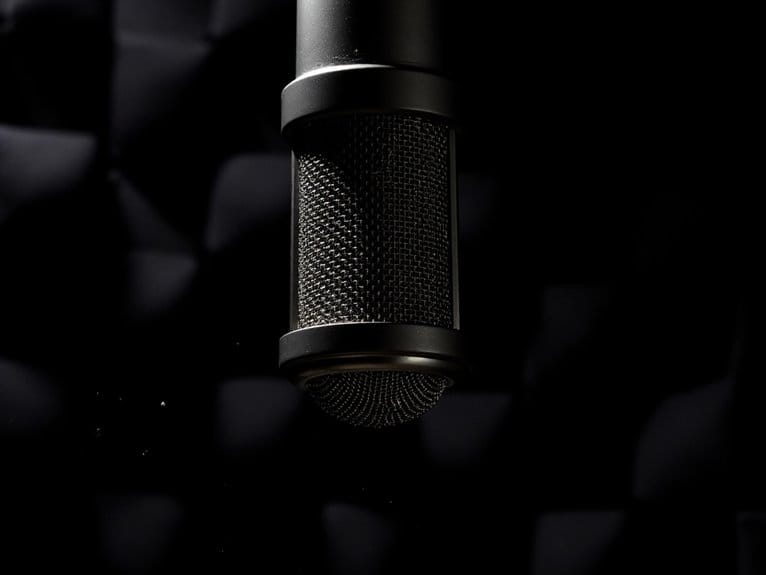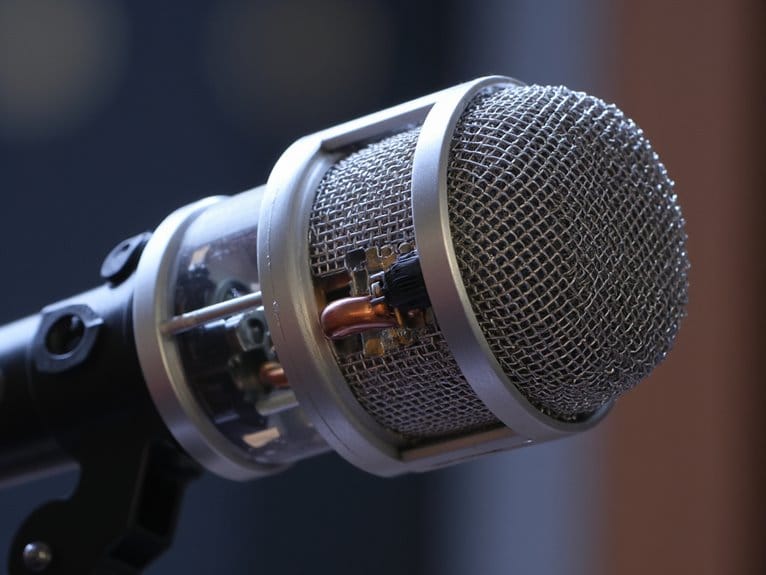Large Diaphragm Vs Small Diaphragm Condensers
You’ll find that large diaphragm condensers, measuring 1 inch or greater, deliver warm, rich vocals with enhanced bass response and higher sensitivity around 22 mV/Pa, making them perfect for lead vocals and studio work. Small diaphragm condensers, typically 16-20mm across, offer precise neutrality with extended highs up to 40 kHz and superior transient response, excelling at capturing acoustic instruments with uncolored accuracy. Your choice depends on whether you prioritize vocal warmth or instrumental precision, though the technical nuances reveal even deeper considerations.
We are supported by our audience. When you purchase through links on our site, we may earn an affiliate commission, at no extra cost for you. Learn more.
Notable Insights
- Large diaphragm condensers (≥25.4mm) offer warmth and vocal presence, while small diaphragm condensers (16-20mm) provide neutral, detailed sound.
- Large diaphragm mics have higher sensitivity (22 mV/Pa) and lower noise floors compared to small diaphragm models (10 mV/Pa).
- Small diaphragm condensers excel at capturing transients and high-frequency details due to their lighter mass and faster response.
- Large diaphragm mics work best for vocals and piano, while small diaphragm mics suit acoustic instruments and percussion.
- Large diaphragm condensers require treated studio environments, whereas small diaphragm mics perform better in challenging acoustic spaces.
Physical Design and Size Specifications
When you’re comparing large and small diaphragm condensers, the most fundamental difference lies in their capsule dimensions, with large-diaphragm models featuring membranes of 1 inch (25.4 mm) or greater in diameter, while their smaller counterparts typically measure between 16 mm to 20 mm across.
The physical design reflects these dimensional differences markedly, as large diaphragm condensers typically weigh between 500g to 1kg with robust metal housing material that accommodates complex capsule assemblies and internal electronics.
Small diaphragm models maintain slimmer profiles under 200g, often utilizing composite materials for portability.
The diaphragm durability of larger models benefits from gold-sputtered membranes and thorough shock mounting systems, while smaller variants prioritize compactness over protective housing, making them ideal for field recording and tight placement scenarios where space constraints matter. Professional large-diaphragm models often include shock mounts and carrying cases as standard accessories to protect their sensitive components during transport and setup. Both types typically require phantom power delivered through XLR connections to operate their internal preamplifiers effectively.
Tonal Character and Sound Coloration
When you’re choosing between large and small diaphragm condensers, you’ll quickly discover that their most defining characteristic isn’t actually their size—it’s how dramatically different they make your recordings sound, with each type imparting its own distinctive sonic fingerprint that can either enhance or completely transform your source material.
Large diaphragm condensers naturally gravitate toward warmth and richness, adding that coveted “larger-than-life” presence that makes vocals sound lush and full, while small diaphragm condensers take the opposite approach by maintaining strict neutrality and transparency that preserves every detail exactly as it exists in the room. The technical foundation for these tonal differences lies in their resonant frequencies, with small diaphragms typically resonating around 8 kHz while large diaphragms resonate around 3 kHz, fundamentally shaping how each microphone responds across the frequency spectrum. The higher sensitivity of LDCs provides a stronger signal compared to SDCs, contributing to their enhanced presence and fuller sound characteristics. Understanding the frequency response characteristics of your microphone becomes crucial since most quality condensers offer impressive ranges like 20Hz-20KHz that capture the full spectrum of human hearing.
I’ve found that understanding this fundamental difference between warmth versus neutrality becomes the cornerstone of making informed microphone decisions, since these contrasting frequency response characteristics will ultimately determine whether your recordings sound enhanced and colored or pristine and unaltered.
Warmth Vs Neutrality
One of the most defining characteristics that separates large and small diaphragm condensers lies in their fundamental sonic personalities. Larger capsules naturally impart a warmer, more colored sound that adds richness and body to recordings, while their smaller counterparts deliver a cleaner, more neutral representation that captures sources with minimal tonal interference.
Your tonal preferences and recording styles will largely determine your microphone choices between these two camps. Large diaphragms excel when you’re seeking creative uses that enhance intimacy, making vocals sound fuller and more present in your mix.
Their sound profile naturally sweetens sources, which proves invaluable across various studio techniques where coloration benefits the final product. This warmth comes from their emphasis on low and midrange frequencies that creates a more intimate recording character.
Small diaphragms shine when your mixing integration demands transparency and accuracy. Their neutral character suits genre suitability requirements for classical, acoustic, and ensemble work where faithful reproduction matters most. Small diaphragm mics provide excellent transient response that captures precise detail and timing in percussion and plucked instruments.
Frequency Response Colors
Although the warmth versus neutrality distinction provides a useful starting point, the real technical story lies in how each microphone type’s physical design creates distinct frequency response curves that color your recordings in measurably different ways.
Large-diaphragm condensers create frequency modulation through their lower resonant frequency, which emphasizes bass regions and provides that coveted “push” in low frequencies. Small-diaphragm condensers, conversely, maintain superior spectral balance by rolling off lows naturally while extending highs up to 40 kHz with remarkable flatness.
| Frequency Range | Large Diaphragm | Small Diaphragm |
|---|---|---|
| Low (20-200 Hz) | Enhanced/Colored | Naturally Rolled |
| Mid (200-2k Hz) | Variable Response | Consistent |
| High (2k-20k Hz) | Limited Extension | Extended/Flat |
This fundamental difference means you’re choosing between enhanced low-end character or pristine high-frequency accuracy. The lower mass of small diaphragm elements allows them to respond more accurately to rapid sound pressure changes, contributing to their exceptional transient response capabilities. Small diaphragm microphones excel with acoustic instruments due to their uncolored reproduction and ability to capture natural timbres.
Frequency Response and Detail Capture
If you’ve ever wondered why different condenser mics sound so distinct from one another, the answer largely comes down to their diaphragm size and how it affects frequency response and detail capture.
Small diaphragm condensers excel at capturing intricate high-frequency details, maintaining flat response up to 40 kHz while delivering superior dynamic range for transient-rich sources like cymbals and acoustic guitars. Their lightweight diaphragms track rapid sound changes with minimal frequency modulation, producing clinically accurate recordings that preserve every subtle nuance.
Large diaphragm models, conversely, emphasize warmth and fullness through their lower resonant frequency and extended low-end response, though they sacrifice some high-frequency precision due to increased diaphragm mass affecting transient response speed.
Vocal Recording Applications
When you’re setting up to record vocals, the frequency response characteristics we’ve just explored translate into very real differences in how your voice will sound through the microphone.
Large diaphragm condensers excel at capturing the warmth and fullness that makes lead vocals sit beautifully in a mix, while their extended low-end response enhances the natural richness of deeper voices.
For vocal layering techniques, you’ll find large diaphragms create cohesive, warm harmonies that blend seamlessly together.
Small diaphragm condensers, however, deliver precise accuracy when you need surgical detail in your vocal recordings, capturing every nuance within your voice’s dynamic range without adding coloration that might compete with other mix elements.
To achieve optimal vocal clarity, position yourself at the recommended distance of 6-12 inches from the microphone capsule.
Keep in mind that condenser microphones require phantom power for operation, which is an essential consideration when setting up your recording equipment.
Instrument Recording Considerations
Moving beyond vocal applications, the choice between large and small diaphragm condensers becomes even more critical when you’re recording instruments, where each microphone’s inherent sonic characteristics can either enhance or undermine the natural voice of your source. I’ve found that understanding these microphone types across different recording genres makes all the difference in capturing authentic performances.
| Characteristic | Large Diaphragm | Small Diaphragm |
|---|---|---|
| Frequency Response | Warm, enhanced low-end | Extended highs, neutral |
| Best Applications | Piano, guitar, drum overheads | Strings, flutes, percussion |
| Transient Response | Slower, emphasizes sustain | Superior, captures attacks |
| Tonal Character | Colored, full-bodied | Accurate, detailed reproduction |
For classical guitar recording specifically, polar pattern selection becomes crucial as cardioid and supercardioid patterns effectively capture guitar sound while rejecting background noise. Proper microphone placement typically involves positioning the mic 6-12 inches from the guitar and experimenting with angles to achieve different tonal results. Your instrument choice ultimately determines which microphone type will serve your recording goals best.
Noise Performance and Sensitivity
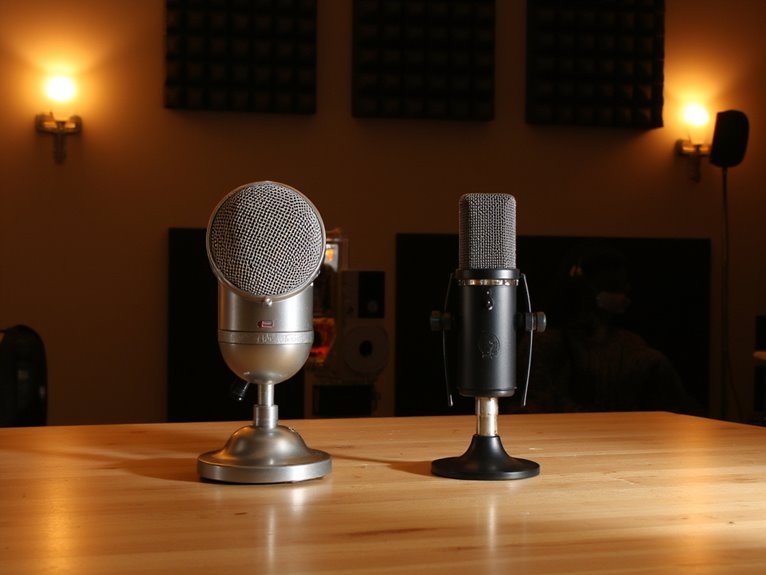
When you’re comparing large and small diaphragm condensers, you’ll notice significant differences in how much electrical signal they generate from the same sound source, with large diaphragm mics typically producing around 22 mV/Pa compared to small diaphragm models at roughly 10 mV/Pa.
This sensitivity gap means you’ll need less preamp gain with large diaphragm condensers, which directly impacts your recording’s noise floor since excessive gain amplifies both your signal and any unwanted background hiss.
The self-noise characteristics between these two designs also differ considerably, as large diaphragm condensers generally maintain lower inherent noise levels due to their easier-to-move diaphragms, while small diaphragm models face design constraints that result in higher noise floors.
Self-Noise Differences Explained
Although both microphone types serve similar recording purposes, I’ve found that large diaphragm condensers consistently outperform their smaller counterparts when it comes to self-noise characteristics, delivering remarkably quieter performance that can make or break your recording quality.
The physics behind diaphragm performance reveals why larger capsules excel in quiet environments. Their increased surface area generates higher output voltage, typically 22 mV/Pa compared to small diaphragms’ 10 mV/Pa, requiring less electronic amplification and subsequently reducing noise amplification.
| Specification | Large Diaphragm | Small Diaphragm |
|---|---|---|
| Self-Noise Level | Lower | Higher |
| Sensitivity | ~22 mV/Pa | ~10 mV/Pa |
| Signal-to-Noise Ratio | Superior | Moderate |
| Quiet Source Recording | Excellent | Adequate |
This sensitivity advantage means you’ll capture stronger initial signals, minimizing the electronic gain needed downstream, which directly translates to cleaner recordings with reduced noise floors. Understanding these performance characteristics is essential for selecting the right microphone, as user experience improves significantly when you match the appropriate diaphragm type to your specific recording requirements.
Signal Sensitivity Comparison
Understanding how sensitivity translates into real-world recording performance, I’ve discovered that the output voltage differences between large and small diaphragm condensers create a cascade of effects that’ll directly impact your recording chain’s noise characteristics.
Large diaphragm mics typically deliver around 22 mV/Pa compared to small diaphragms‘ 10 mV/Pa—these sensitivity metrics reveal why LDCs capture quieter sounds more effectively.
When you’re using SDCs, you’ll need higher preamp gain to achieve comparable recording levels, which can introduce additional electronic noise if your preamp isn’t stellar.
The larger surface area in LDCs generates stronger output voltage naturally, reducing your reliance on gain stages and keeping your signal-to-noise ratio healthier throughout the recording chain.
Pickup Pattern Consistency
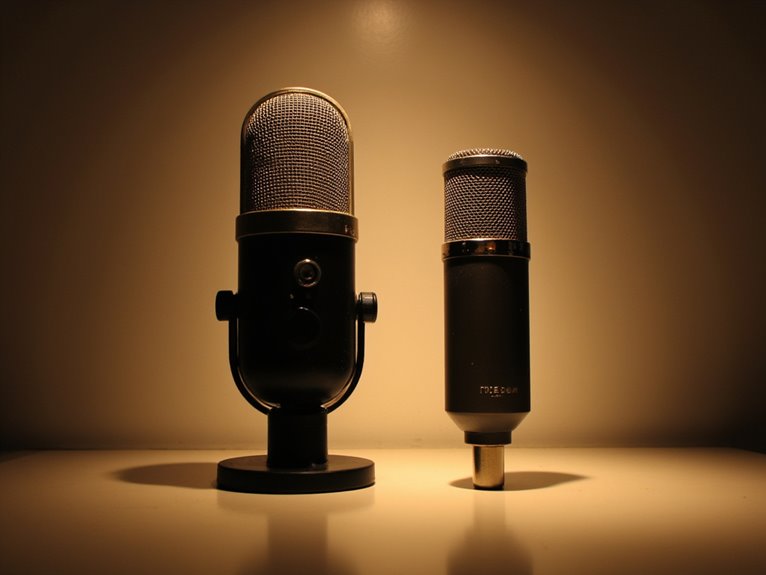
If you’ve ever wondered why your recordings sound different depending on where instruments are positioned relative to your microphone, the answer often lies in pickup pattern consistency—one of the most significant yet overlooked differences between small and large diaphragm condensers.
Small diaphragm mics maintain remarkable pickup pattern stability across the entire frequency spectrum, meaning their cardioid response stays consistent from bass to treble without frequency variation.
Small diaphragm condensers deliver unwavering cardioid consistency from low to high frequencies, ensuring reliable pickup patterns across the entire audio spectrum.
Large diaphragm condensers, however, behave like chameleons—acting omnidirectional at low frequencies and hypercardioid at highs. This inconsistency creates uneven sound imaging, where off-axis instruments sound dull and lifeless.
For distant miking applications like orchestral recording, small diaphragms preserve brightness and fullness uniformly, while large diaphragms can leave your mix sounding unbalanced and unnatural. Cardioid patterns focus on the primary sound source while rejecting background noise, making them particularly effective in these challenging recording situations. This consistency becomes crucial for recording large sound sources like orchestras or choirs where maintaining uniform capture across all frequencies is essential. Professional microphones with frequency response ranging from 20Hz to 20kHz ensure detailed sound capture across this entire spectrum.
Recording Environment and Placement Factors
The recording environment you choose fundamentally determines which diaphragm size will serve your project best, and I’ve learned through countless sessions that ignoring this relationship often leads to disappointing results that could’ve been easily avoided.
Large diaphragm condensers excel in acoustically treated studios where their enhanced sensitivity captures nuanced vocal performances, but they’ll mercilessly expose room reflections and ambient noise in untreated spaces.
Small diaphragm mics shine in challenging environments, offering superior directional control and reduced room interaction through precise mic placement techniques.
When you’re working in smaller rooms or live environments, recording techniques favor small diaphragms since they maintain neutral frequency response even when close-miked, while large diaphragms require careful positioning to avoid proximity effect complications and unwanted room coloration.
The signal-to-noise ratio significantly influences your microphone choice, as better ratios help achieve cleaner, professional-quality recordings that enhance the overall listener experience.
Proper acoustic treatment enhances sound capture by reducing unwanted reflections and echoes, making it essential for achieving professional recordings regardless of which diaphragm type you choose.
Frequently Asked Questions
What’s the Typical Price Difference Between Large and Small Diaphragm Condensers?
When you’re doing price comparisons for budget considerations, you’ll typically find large diaphragm condensers cost more across all ranges.
Entry-level LDCs run $80-$230, while small diaphragm models often price slightly lower.
Mid-range shows $300-$900 for large diaphragms, with small diaphragms generally less expensive due to simpler construction.
High-end large diaphragm condensers can exceed $3,000-$7,895, commanding significant premiums over their small diaphragm counterparts.
Do Large Diaphragm Mics Require Different Preamp Gain Settings Than Small Diaphragm?
You’ll definitely need different preamp settings between these microphone types, and honestly, it’s pretty straightforward once you understand microphone sensitivity differences.
Large diaphragm mics produce hotter output signals, so you’ll use less preamp gain to reach ideal recording levels.
Small diaphragm condensers require more aggressive gain increases due to their lower sensitivity, though they handle the extra amplification well without distorting.
Which Microphone Type Works Better for Live Streaming and Podcasting Applications?
For live streaming and podcasting, you’ll want large diaphragm condensers since they deliver superior audio quality with that warm, rich vocal presence your audience craves.
While I’ve tested both types extensively, LDCs consistently outperform small diaphragms in live performance scenarios, capturing subtle voice nuances and providing the professional sound that keeps listeners engaged throughout longer content sessions.
On a final note
You’ll find that both large and small diaphragm condensers serve distinct purposes in your recording arsenal, and honestly, I’ve learned that choosing between them isn’t about which is “better” but rather which fits your specific application. Large diaphragms excel at capturing vocals with warmth and presence, while small diaphragms deliver precise detail for acoustic instruments and overhead recording, so you’re really selecting the right tool for each job.

